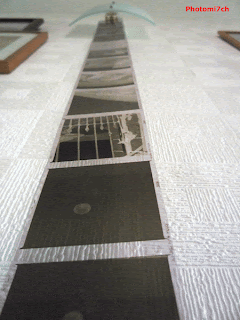The
use of out of date film has become very popular over the last few
years. So much so that it has become a bit of a sub culture within
the film world, with some photographers stating that it is all they
use. I get the impression that in some cases there is a bit of grand
standing, look at me, my photography is better because of it! If it
has improved your picture making then all well and good, but I have
to say that some of the images I have seen makes me wonder why did
they bother! I personally see no advantage in using out of date,
apart from the fact it is slightly less expensive than fresh.
Lets
be honest about this how often do you end up with a blank film?
But
then again there is a certain extra thrill in the knowledge that when
you take the lid off the developing tank and view the wet film with
nicely exposed negatives, a sense of relief at your gay abandonment
to the natural order of things was worth the risk. In my experience
the risk is very small but if you read some blogs it is a step to far
to contemplate.
 |
| 120 Fujicolour Superia out of date by 10 years. |
So
why would you treat out of date film to a different set of process
times?
I
have always used out of date film long before it became popular. I
just keep using the film stock till it runs out. It was not until
recent times that I have taken note of the process before date and
now that I have that knowledge it has not made any difference to the
way I make images and process the film. When comparing them to in
date negatives of the same make I can see no difference.
 |
| 120 Fujicolour Superia out of date by 10 years. |
So
how do you store your film?
There
is a lot of myth and misunderstanding about how to store your film
after you have purchased it. The one thing that destroys film faster
than anything else is humidity. Even in these situations, as long as
the film is kept in its sealed containers and wrappers (medium
format) it will remain in good condition. So common sense would
suggest that you only break the film out when you are about to use
it. Surely?
So
why would you need to store it in a fridge or freezer?
I
used to do this until I was caught out by not getting the film from
the fridge the day before. I seriously questioned whether there was
any advantage to doing it. Common sense suggested that the weather in
the UK never really gets that extreme so why bung the fridge up?
-(there was a cheer from the other half when I removed it all!) -
after all, I purchased it to use, not stock pile. Obviously
everyone's circumstances are different. But I have found a growing
number of people who store film in a draw find it more convenient and
allows for spontaneity. Not having to second guess myself about will
I or Won't I need a film tomorrow has freed up creativity.
With
this in mind I purchased a carton of out of date film. It is a
mixed box of T max 400, Ilford delta 100, 3200 and XP2 400. I did
this because I had been toying with the idea of trying out TMAX 400,
but it then occurred to me that I had never used the others either.
So now is my chance. I was told they had all been stored in a draw
and were still in the sealed wrappers. Good enough for me!
This
selection of emulsions are a maximum of seven years out of process
date. I have used so far the delta 100 and 3200 at box speed.
Developed in RO9 @1+50 @20C using my usual method. The results are
what I would expect from fresh stock.
There
is a down side, it can go wrong occasionally, but it is a lot rarer
than people would have you believe and it is more than likely to be
human error than failure of materials. Some of you will be
uncomfortable with the idea and I understand that reticence,
especially if you are new to film photography.
I
have written two other posts on the subject: Film storage - is
a more technical look and colour out of date - which talks
about an old film left in the camera for years. My view on film
storage has not changed as these other post will reinforce. Remember
do not be influenced by other peoples narrow mindedness. Photography
is about being creative and that means there are no rules.
 |
| Out of film Delta 3200, dev RO9, printed on Adox MCP |
Here is a link to the delta film mentioned earlier in the article.
Updated 2022:
Since writing this there is a downside to out of date film. It is unexpected and inconsistent in its appearance and affects black and white 120 film so far. The main reason for it is the paper backing, for some reason it can produce a blotchy look to the negatives which is most noticeable in the sky detail.
The following pictures show the affect:
Technical data:
The black and white images were scanned from photographs.
Camera used was a Bronica SQAi with a 120-format film back.
Black and white film used for the pictures above Fomapan 100 with the black backing paper. They have recently changed the paper to the same one Ilford use. you can see what the different backing papers look like here











